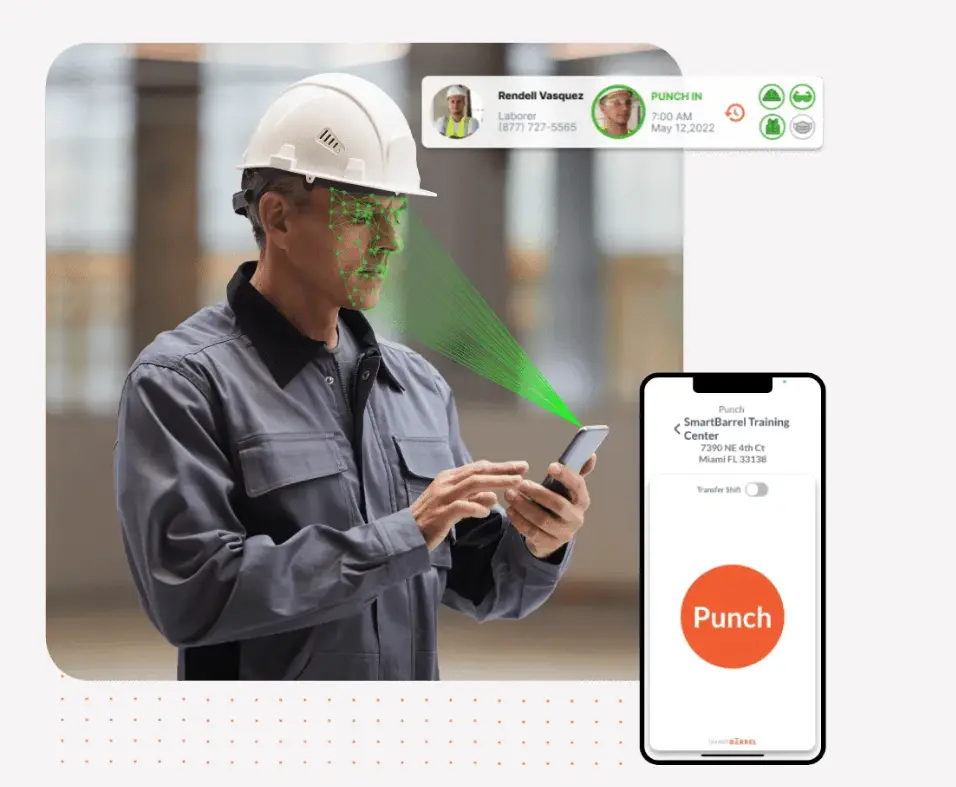Running a jobsite goes smoother with daily progress reports. They keep everyone aligned, make tracking easier, and give you a clear picture of what’s happening. It’s like using time cards for payroll – simple, consistent, and helpful. With DPRs, you’re set up for better communication, smarter decisions, and fewer surprises along the way.
Here’s the truth: daily reports aren’t “nice-to-have.” They are a must. Stay ahead with real-time updates—save time, cut costs, and keep control without chasing info through texts or calls.
According to Autodesk, the construction teams waste over 14 hours a week on issues that shouldn’t even be issues, such as rework, missing information, and miscommunication. That’s because the critical details never get documented.
A proper daily report provides exactly what you need: who was there, what got done, what didn’t, and what slowed the tasks. No fluff. No guessing. Just the facts. It’s your reality check every day. Without it, you are exposed to risk: schedule delays, payment disputes, legal issues, and blown budgets.
Want to take control? Start with documentation. Lock in the truth daily and keep your job moving forward.

Get Control of Your Time Tracking
What does DPR stand for in Construction?
A construction daily progress report (DPR) provides a clear overview of what happened on the jobsite, including work completed, headcount, equipment, weather, deliveries, incidents, and delays. It is filled out by the foreman or site lead and then sent to the PM or back office, keeping everyone aligned without constant check-ins.
A DPR in construction isn’t just internal paperwork. It protects you. If there’s a dispute or claim, a well-documented DPR backs your side. It also provides answers to the owner’s weekly “what got done?” question without guessing.
Manual DPRs were a real headache. Recalling delays, labor issues, or missed deliveries at the end of a long day is nearly impossible if you are relying on memory or messy notes. Now there are tools that allow you to log updates in real-time while things are fresh and accurate.
The bottom line: switching from paper or ad-hoc processes to a streamlined system is a smart move that puts you ahead. Get your reporting under control, and you will keep your project tight and defensible.
Purpose of Daily Progress Report in Construction
The purpose of a daily progress report in construction is simple: to keep the job moving, reduce confusion, and protect your bottom line. Every DPR in construction documents who was at the jobsite, what work was done, what equipment was used, and what issues came up. This daily habit keeps teams aligned and cuts down on miscommunication, which is the #1 reason projects get delayed.
It also improves how you work with clients. Instead of fielding vague complaints or questions about slow progress, you have daily records that show exactly what happened and why. That transparency builds trust and helps to get invoices paid without friction.
Tracking the work every day also helps you manage time. You see the actual progress, not what you think got done. Missed tasks, slipping schedules, or repeating delays show up faster, and you can fix them before they cost more.
And if something goes wrong, whether it is a dispute over hours, missing materials, or weather delays, your report is your proof. With signed entries, photos, and details, you have the backup to settle issues quickly
Even good client relationships change. People leave. Verbal agreements get forgotten. Logging things daily builds a strong foundation of protection—simple steps today can save time and stress down the road.
Key Components of a Daily Progress Report
A solid daily progress report format keeps your jobsite organized and protects you from disputes, delays, and confusion. Here’s what a no-nonsense daily progress report should include:
- General Information: Project name, location, date, report number, and who filled it out. Put this at the top so there is no confusion.
- Progress Photos: Include photos to show completed work, material issues, or delays. Don’t rely on text alone.
- Weather Information: Note temperature, precipitation, and conditions. Bad weather can slow progress, which causes document delays.
- On-Site Personnel Information: List headcount by crew, subcontractor, and role. This is useful for labor tracking and payroll alignment.
- Site Visitors Information: Log anyone not part of the daily crew. This helps with safety compliance and accountability.
- Work Performed: What tasks were done today, and what is their status (to-do, in progress, and done)? Keep it task-specific.
- Next Day Plan: List what’s scheduled for tomorrow so crews can prepare without excuses or surprises.
- Daily Timesheet: Record who worked and for how long. Helps spot gaps and manage labor costs.
- Equipment Used: Track what equipment was on-site, who used it, and how long it ran. Crucial for billing and maintenance.
- Material Usage: List materials used today with type and quantity. Helps control inventory and avoid reordering surprises.
- Deliveries: Log what showed up—and what didn’t. Missed deliveries can throw the schedule off.
- QC Inspections: Note any quality checks, pass/fail outcomes, and follow-up needed.
- Delays: Document what held up the job (weather, missing crew, failed delivery, broken equipment, etc.).
- Incidents/Safety Issues: Accidents, near misses, or hazards must be logged. No excuses.
- Signatures: Whoever fills out the report signs it. This makes the record official and accountable.
Your DPR is only as good as your accurate time tracking data – without verified hours, you’re building reports on guesswork.
Get Control of Your Time Tracking
How to Make a Daily Progress Report in Construction?
Filling out a daily progress report for construction site work doesn’t need to eat up your evening. But skipping it or rushing through it? That’s how small issues turn into big problems.
The easiest way to get your report done right is to use a daily progress report format for construction site tasks that’s consistent, detailed, and built around the realities of the field. Start with general job information such as project name, location, and report date. Then move through the essentials: crew on-site, subcontractors, equipment used, material consumption, and delivery records. Add a section to track inspections, delays, and any issues that come up, whether it is bad weather, a broken machine, or missing supplies.
In the past foreman used to log all of this information manually, scribbling in notebooks or trying to remember details at the end of a long day. That method isn’t just slow, but also risky. If you can’t document what happened, you are exposed to delays, missed payments, and disputes you can’t prove.
Now, you can build a daily report as you go using field apps. These let you log progress, snap photos, use voice-to-text, and automatically capture weather. You can even get signatures on the spot and upload reports directly to the cloud. Whether it is digital or on paper, the key is consistency. If it didn’t get documented, it didn’t happen.
Advantages of Making a Daily Progress Report in Construction
- Track Resource Usage: A daily report shows exactly what labor, materials, and equipment were used. This helps manage costs, control inventory, and catch waste before it adds up.
- Spot Issues Early: Daily documentation makes it easier to see when schedules slip or when costs start trending off plan. That means you can step in and fix problems before they grow.
- Keep Progress Accurate: With a construction daily report, you get consistent updates that reflect what’s actually happening. That makes end-of-week or end-of-month reports easier to build and more accurate.
- Keep Stakeholders Informed: Clients and other stakeholders don’t need constant calls or meetings. Daily reports give them a clear picture of what’s going on and why.
- Support Delay Claims: When delays happen, a daily report provides the documentation to figure out what caused it and who is responsible. Weather, late deliveries, or change orders are no longer up for debate.
Mistakes to Avoid in Daily Reporting
Here’s a clear breakdown of common mistakes that can ruin a daily progress report for construction sites. These issues waste time, confuse the team, and put you at risk during disputes or audits.
Mistake | Why It’s a Problem |
Vague Descriptions | Work done or progress made means nothing. Be specific about what was done, where, and by whom. |
Late Submission | Filling out reports days later leads to missing or inaccurate info. Log in on the same day. |
Hiding Problems | Leaving out delays or issues creates bigger problems later. If it happened, then document it. |
Inconsistent Format | If teams use different formats, nobody knows what they are looking at. Use a standard daily progress report template. |
No Photos | Skipping photos kills your proof. Visuals back up labor, materials, and job completion. |
A bad DPR creates a false sense of control. If facts aren’t logged daily, accurately, and consistently, it’s easy for things to slip. Stay sharp—clear records lead to smoother projects.
Get Control of Your Time Tracking
How to Streamline Daily Progress Reports with Technology
Manual daily reporting is time-consuming and can be inaccurate. If your team is scribbling notes, texting photos, and trying to remember details hours later, you are asking for mistakes. A solid daily progress report for construction site tracking needs to happen in real-time, not at the end of a long shift.

That’s where SmartBarrel comes in. When crews clock in using a facial verification time clock, attendance data is automatically logged and integrated into daily progress reports without any manual data entry. Supervisors can add progress notes, tag photos, and even log breaks or incidents using SMS receipts, all while they are still on the job.
Everything is stored in the cloud, so the office doesn’t have to wait. Project managers, payroll teams, and field leads can all access the same data without back-and-forth emails or digging through folders. Automated timesheets are ready for export, and reports are backed by verified data, not memory.
Using SmartBarrel helps you build a consistent daily progress report that’s fast, accurate, and easy to share. No more chasing info. No more rework. Just clean reporting you can count on.
Conclusion
If you’re still chasing hours, fixing errors, or sorting out missed work, there’s a better way—one that saves time and money. SmartBarrel gives you verified time tracking, real-time jobsite data, and payroll-ready reports without the hassle. No more guessing. No more back-and-forth. You can stay in control, your crew stays accountable, and every hour gets counted.
Take control of your jobsite – book your SmartBarrel demo now and see the difference in your first week.





